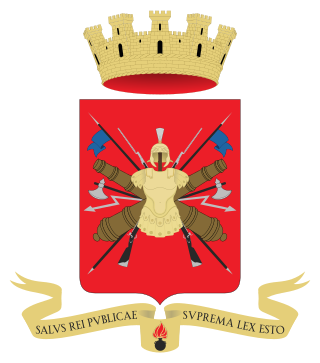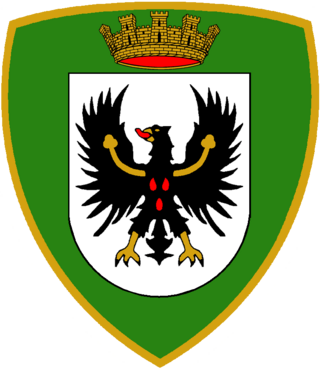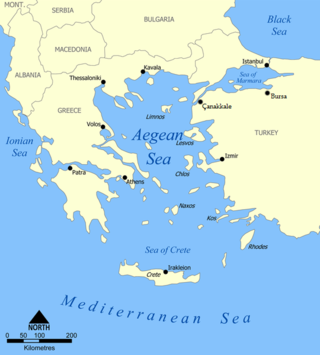
The Supreme Headquarters Allied Powers Europe (SHAPE) is the military headquarters of the North Atlantic Treaty Organization's (NATO) Allied Command Operations (ACO) that commands all NATO operations worldwide. SHAPE is situated in the village of Casteau, near Mons, Belgium.

The 15th Army Group was an army group in World War II, composed of the British Eighth Army and initially the Seventh United States Army (1943), replaced by the Fifth United States Army, which apart from units from across the British Empire and United States, also had entire units from other allied countries/regions, including: one corps from Free France and one from Poland; one division from Brazil; multiple separate brigades of Italians and Greeks; plus support to, and from, local Italian partisans. It operated in the Italian Campaign from 1943 to 1945.

Allied Joint Force Command Brunssum (JFCBS) is a NATO command with its headquarters at Brunssum, the Netherlands. It was established in 2004, as part of a reorganisation that reduced the number of NATO Military Command Structure headquarters.

The Italian Army is the land force branch of the Italian Armed Forces. The army's history dates back to the Italian unification in the 1850s and 1860s. The army fought in colonial engagements in China, Libya, Northern Italy against the Austro-Hungarian Empire during World War I, Abyssinia before World War II and in World War II in Albania, Balkans, North Africa, the Soviet Union, and Italy itself. During the Cold War, the army prepared itself to defend against a Warsaw Pact invasion from the east. Since the end of the Cold War, the army has seen extensive peacekeeping service and combat in Afghanistan and Iraq. Its best-known combat vehicles are the Dardo infantry fighting vehicle, the Centauro tank destroyer and the Ariete tank and among its aircraft the Mangusta attack helicopter, recently deployed in UN missions. The headquarters of the Army General Staff are located in Rome opposite the Quirinal Palace, where the president of Italy resides. The army is an all-volunteer force of active-duty personnel.

The Joint Force CommandNaples is a NATO military command based in Lago Patria, in the Metropolitan City of Naples, Italy. It was activated on 15 March 2004, after effectively redesigning its predecessor command, Allied Forces Southern Europe (AFSOUTH), originally formed in 1951. In NATO Military Command Structure terms, AFSOUTH was a "Major Subordinate Command". The commander of JFC Naples reports to the Supreme Allied Commander Europe at the Supreme Headquarters Allied Powers Europe, Casteau, Belgium.
Hüseyin Kıvrıkoğlu is a retired Turkish general who was the 23rd commander of the Turkish Armed Forces and on August 30, 1998, became Chief of the Turkish General Staff for a four-year term.

Lieutenant General Thomas R. Turner II is a retired United States Army officer, who served as the commander of the 101st Airborne Division and United States Army North, Fort Sam Houston, Texas.

Caserma Ederle is a military complex in Vicenza, Italy, where the United States Army has troops stationed. It is under Italian military control and can be managed anytime by the Italian authorities. The Vicenza Military Community is composed of soldiers, family members, civilians and retirees with a small number of airmen and sailors also stationed there. The post serves as the headquarters of United States Army Africa and the 173rd Airborne Brigade. Caserma Ederle serves as the headquarters of U.S. Army Garrison Italy of the United States Army Installation Management Command, an umbrella for all U.S. military properties in Vicenza. The post is named after Major Carlo Ederle, an Italian hero of World War I and recipient of the French Croix de Guerre, among other military honors.

The Alpine Brigade "Orobica" was a light Infantry brigade of the Italian Army, specializing in mountain warfare. Its core units were Alpini, the mountain infantry corps of the Italian Army, that distinguished itself in combat during World War I and World War II.

The Alpine Brigade "Tridentina" was a light Infantry brigade of the Italian Army, specializing in mountain warfare. Its core units were Alpini, the mountain infantry corps of the Italian Army, that distinguished itself in combat during World War I and World War II. The Alpine Brigade "Tridentina" carried on the colours and traditions of the WWII 2nd Alpine Division "Tridentina".

The Comando Truppe Alpine or COMTA commands the Mountain Troops of the Italian Army, called Alpini and various support and training units. It is the successor to the 4º Corpo d'Armata Alpino of the Cold War. The Alpini are light Infantry units specializing in Mountain Combat. The subordinate units of the COMTA distinguished themselves during combat in World War I and World War II.

The Northern Army Group (NORTHAG) was a NATO military formation comprising four Western European Army Corps, during the Cold War as part of NATO's forward defence in western Germany.
The structure of the North Atlantic Treaty Organization (NATO) is complex and multi-faceted. The decision-making body is the North Atlantic Council (NAC), and the member state representatives also sit on the Defence Policy and Planning Committee (DPPC) and the Nuclear Planning Group (NPG). Below that the Secretary General of NATO directs the civilian International Staff, that is divided into administrative divisions, offices and other organizations. Also responsible to the NAC, DPPC, and NPG are a host of committees that supervise the various NATO logistics and standardisation agencies.

Exercise Longstep was a ten-day NATO naval exercise held in the Mediterranean Sea during November 1952 under the overall command of Admiral Robert B. Carney, USN, the Commander-in-Chief Allied Forces Southern Europe (CINCAFSOUTH). This exercise involved over 170 warships and 700 aircraft, and it featured a large-scale amphibious assault along the western coast of Turkey. With Exercise Grand Slam, this exercise served as the prototype for future NATO maritime exercises in the Mediterranean Sea during the Cold War.

Allied Air Forces Central Europe (AAFCE) was the NATO command tasked with air and air defense operations in NATOs Allied Forces Central Europe (AFCENT) area of command.

The III Army Corps was one of three corps the Italian Army fielded during the Cold War. Based in the regions of Lombardy and Piedmont the corps was the army's operational reserve, while the 4th Alpine Army Corps and the 5th Army Corps, both based in the North East of Italy, were the army's front-line units. After the end of the Cold War the corps was reduced in size and on 1 December 2000 it ceded its last brigades to the 1st Defence Forces Command. The personnel of the 3rd Army Corps was used to raise the NATO Rapid Deployable Italian Corps in January 2001.

The V Army Corps was one of three corps the Italian Army fielded during the Cold War. Based in the regions of Veneto and Friuli-Venezia-Giulia the corps was the army's main combat force. The 5th Army Corps was arrayed close to the Yugoslavian border and tasked with meeting any Warsaw Pact forces that crossed the border. On the left flank of the corps the 4th Alpine Army Corps was tasked with blocking the Alpine passes and in the rear of the corps the 3rd Army Corps served as operational reserve. After the end of the Cold War the corps was reduced in size and on 1 October 1997 it became the 1st Defence Forces Command. In 2013 the COMFOD 1° was disbanded and its function and brigades taken over by the 20th Infantry Division Friuli in Florence.

The 3rd Missile Brigade "Aquileia" was an artillery brigade of the Italian Army active between 1959 and 1991. The brigade was stationed in North-Eastern Italy and armed with missile and artillery systems capable of firing tactical nuclear weapons as part of Italy's participation in NATOs nuclear sharing programme. During peacetime the brigade fell under command of the Italian V Army Corps, but during wartime the brigade would have been subordinate to NATOs Allied Land Forces Southern Europe (LANDSOUTH) command in Verona. After the end of the Cold War the brigade was disbanded and its weapon systems retired.
The 3rd Army was a World War I and World War II field army of the Royal Italian Army and the only army-level command of the Italian Army during the Cold War.

The United States Army NATO Brigade (USANATO) is a US Army brigade providing training, logistics, human resources, and service-specific support at 81 US Army NATO locations across 21 countries. The brigade headquarters is based in Sembach in Germany.

























